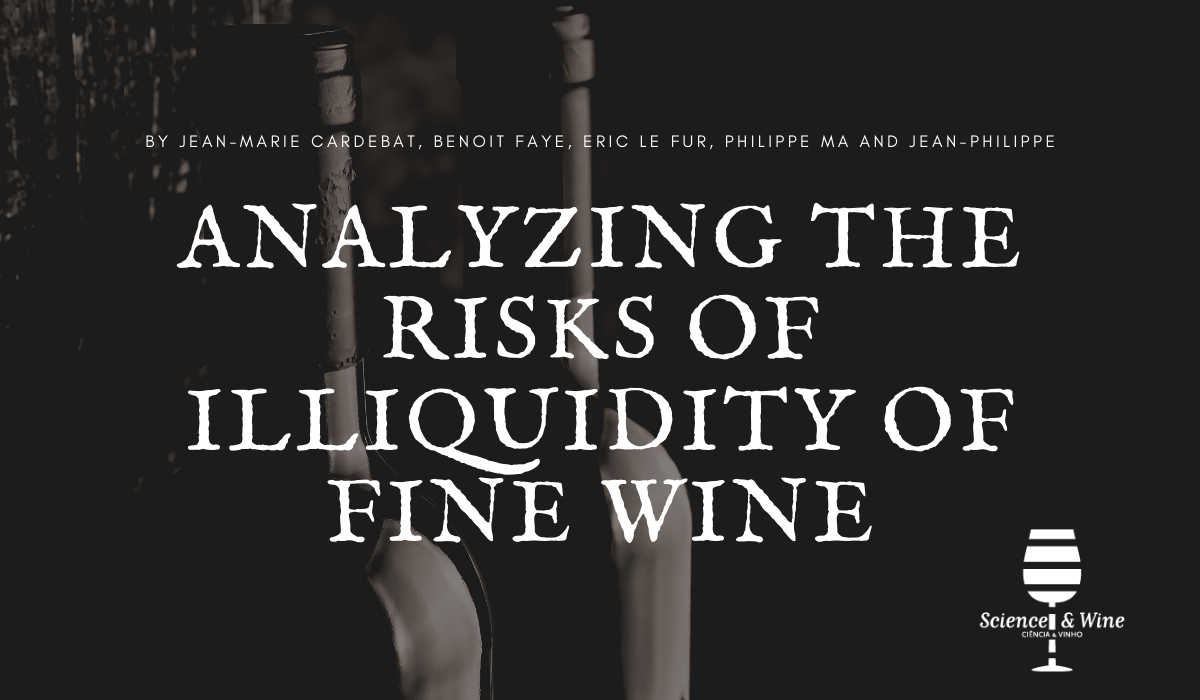By Jean-Marie Cardebat, Benoit Faye, Eric Le Fur, Philippe Ma and Jean-Philippe
Since the early 2000s, fine wines have become increasingly popular. This attractiveness is due to the strong performance of fine wines, combined with low risk and correlations compared to other assets. The academic literature has essentially focused on two issues. The first is a static analysis of the determinants of wine prices (e.g. influence of natural endowments, climatic conditions during the growing season, grape variety used in the blend, winemaking techniques, producer reputation and expert evaluation). The second addresses the dynamics of wine prices. It is less extensive and generally more recent. This literature mainly evaluates the performance of an investment in wine as if wine were a traditional financial asset traded on a financial market. However, fine wine is an emotional asset that is very sensitive to human behavior. Furthermore, it is a globally transportable asset and therefore subject to currency fluctuations. In addition, it does not offer cash flow. The structure of the fine wine market is also complex and suffers from multiple sources of inefficiency that make it relatively illiquid.
Thus, the illiquidity of the wine market is primarily due to the organization of the market and the nature of the asset. Fine wines are traded through multiple channels and in various locations around the world. This lack of a single market prevents aggregation to a single price for each wine. Many market frictions compound the situation such as direct trading costs, large shipping, storage and insurance costs, research costs, market opacity and information asymmetries. A lack of liquidity directly affects asset returns and statistical characteristics. When trading activity in wines is not regular or insufficient, there may be a lag in prices and an underestimation of volatility. In addition, like other illiquid assets, fine wines also tend to react much less quickly to new information than traditional assets.

In order to develop a more accurate estimate of the real performance that wine can offer, This can be done in three steps. First, the data set analyzed must represent a large majority of the transactions on the most sought-after wines in the world. The first growths of Bordeaux are able to meet this expectation. Indeed, even though many other wines are traded worldwide, the top five Bordeaux wines represent a significant portion of the overall wine market in terms of number of transactions and values at major auction houses. Second, the analysis must be based on a methodology that controls for illiquidity in the wine market. Within this framework, a total beta can be estimated as the sum of current and lagged factor exposures. In addition, to better understand the linkage effects between wine and stock markets, different sampling frequencies can be studied. This approach allows to identify sources of risk that illiquidity and exchange rates may represent for investors. Third, we then simply add a liquidity risk premium and two exchange rate risk premiums to the standard capital asset pricing model (CAPM).
This approach yields very different results from those displayed in the prior academic literature indicating that wine investments are riskier than commonly thought. Indeed, fine wines are relatively risky with an annualized volatility of 25-30%. The diversification benefits of fine wines are also less attractive than previously reported results. Fine wines thus trigger a positive market risk premium. Finally, a significant fraction of fine wine returns are due to liquidity risk and currency risk. The exposure of fine wines to these two sources of risk is positive and often statistically significant. These results suggest that market, liquidity and currency risks affect various asset classes and are not specific to stocks. Moreover, given that fine wines are among the most actively traded collectibles and not necessarily the easiest to ship, it is highly likely that other collectibles are at least equally sensitive to these two risks.
Read more at: Masset, P., Weisskopf, J. P., Cardebat, J. M., Faye, B., & Le Fur, E. (2021). Analyzing the risks of an illiquid and global asset: The case of fine wine. The Quarterly Review of Economics and Finance, 82, 1-25.

Jean-Marie Cardebat 
Benoit Faye 
Eric Le Fur 
Philippe Masset 
Jean-Philippe Weisskopf 
Jean-Marie Cardebat (jean-marie.cardebat@u-bordeaux.fr) is full professor of Economics at the University of Bordeaux, where he leads the LAREFI research center, and he is affiliate professor at INSEEC School of Business and Economics. He is the President of the European Association of Wine Economists. He is also a Member of the French delegation at OIV (International Organisation of Vine and Wine), of the ISVV (Scientific Institute of Wine and Vineyard), of the AAWE (American Association of Wine Economists), and of the advisory board of the Journal of Wine Economics. Jean-Marie Cardebat has written many articles and books dedicated to Wine Economics. His book “Economie du vin” has been translated into Chinese (2019), while his last book (as editor), “The Palgrave Handbook of Wine Industry Economics”, received the 2019 prize as best book in Economics from the International Organization of Vine and Wine (OIV).
Benoit Faye (bfaye@inseec.com) is full professor (HDR) at INSEEC Grande Ecole and associate researcher at the University of Bordeaux (LAREFI). His research focuses on alternative hard assets including residential real estate, contemporary art and fine wines. He is particularly interested in understanding the price structure of these assets and their price co-movements. He is co-founder of the INSEEC Chair of Wine Economics and a member of the scientific committee of the European Association of Wine Economists. He has published numerous articles on wine economics and finance in international scientific journals.
Eric Le Fur (elefur@inseec.com) is currently Full Professor (HDR) at INSEEC Grande Ecole and associate researcher at the University of Bordeaux (LAREFI). He is a founding member of Bordeaux Wine Economics and a co-funder of the INSEEC Chair of Wine Economics. He is member of the European Association of Wine Economists. His research currently focuses on wine economics, passion investments (art, classic cars, rare whisky), and wealth management. He has published in peer-reviewed journals such as Applied Economics, Applied Economics Letters, British Food Journal, Economic Modelling, Emerging Markets Review, International Journal of Wine Business Research, Journal of Asset Management, Journal of Wine Economics, Quarterly Review of Economics and Finance, Urban Studies).
Philippe Masset (philippe.masset@ehl.ch) is currently Associate Professor of Finance at the École Hôtelière de Lausanne (EHL). He is a founding member of the Alliance for Research on Wine & Hospitality Management, and a member of the board of the European Association of Wine Economists. His research currently focuses, amongst others, on wine economics, hospitality economics, and alternative investments. He has published in peer-reviewed journals (e.g., Journal of Wine Economics, Economic Inquiry, Economic Modeling, Journal of Alternative Investments) as well as contributed to book chapters and conference proceedings. He has received the award for the best conference presentation at the annual meeting of the European Association of Wine Economics (in 2011, University of Angers) and at the annual meeting of the American Association of Wine Economics (2012, Princeton University).
Jean-Philippe Weisskopf (jean-philippe.weisskopf@ehl.ch) is Associate Professor of finance at the Ecole hôtelière de Lausanne (EHL). His research focuses on empirical corporate finance and wine economics. Jean-Philippe has published in prestigious academic journals in finance and economics, including the Review of Financial Studies, Journal of Banking & Finance, Journal of Corporate Finance, Journal of Alternative Investments and Economic Inquiry. His research has been reported in major media such as Reuters, Bloomberg, The Financial Times, The South China Morning Post, Les Echos, NZZ or La Repubblica. He received the EHL best researcher award in 2016 and the best teacher award in 2021.

